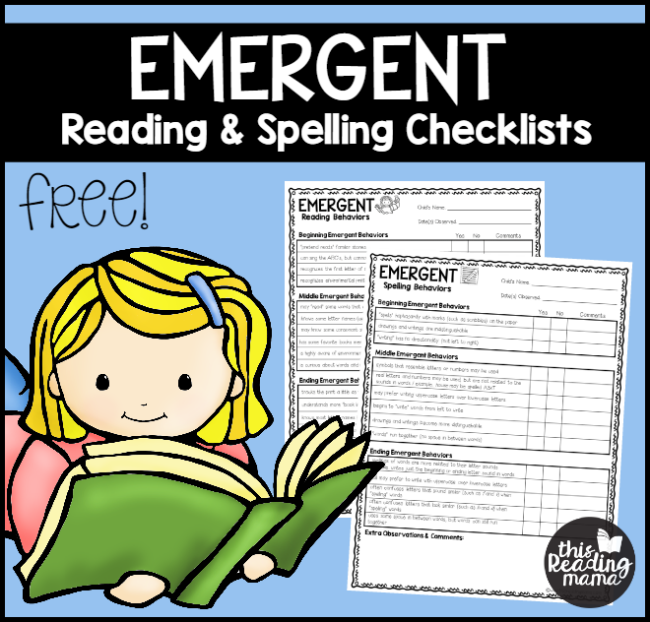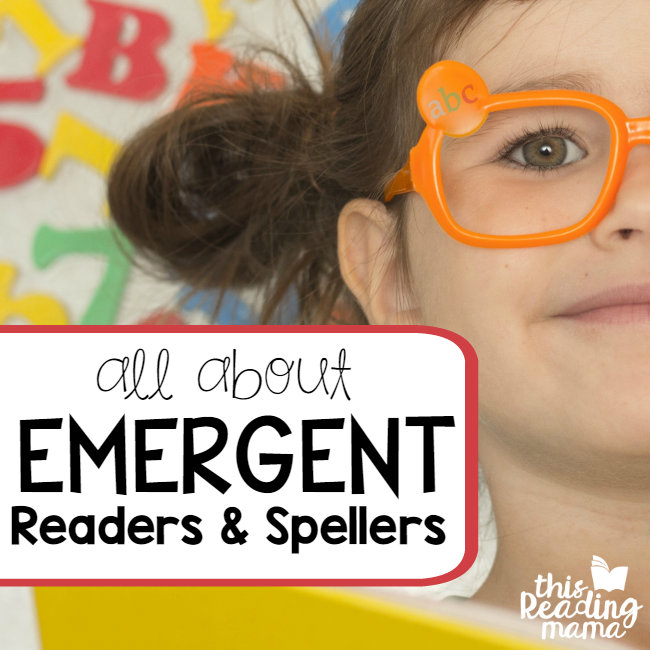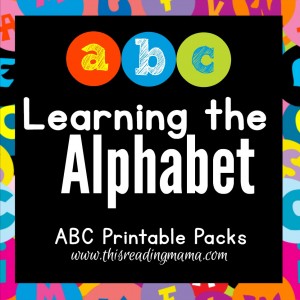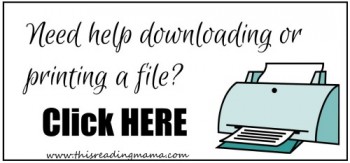Welcome to the first part of my series on the 5 Stages of Literacy Development. Today we’re exploring emergent readers and spellers, which is stage 1.
Terms such as prealphabetic or pre-readers also applies to emergent readers and spellers. These are children who are typically Pre-K through Kindergarten, although it may certainly include younger and older readers/spellers, too. Almost everything these children do is unconventional because they are just beginning to explore reading and writing.

*This post contains affiliate links.
Stage 1: All About Emergent Readers & Spellers
Below are some emergent reading and spelling behaviors you might notice of a child in this stage of literacy learning. Please note that these “checklists” aren’t meant to restrict you or your child/student. They are merely a tool to help us become more observant in regards to what our kids know or don’t know yet. And we can use this information to guide our teaching.
Many of these characteristics were collected from Words Their Way, a spelling program rooted in the developmental needs of kids.

You can also download this printable list HERE.
Emergent Reading Behaviors
At the Beginning:
- “pretend read” stories
- can sing their ABC’s, but usually cannot single out particular letters
- may recognize the first letter of their name
- recognize environmental print, such as the name of their favorite cereal or those famous golden “M” arches
In the Middle:
- may be able to “read” some words that are important to them, such as their name, but may think that other words beginning with the first letter of their name are also their name
- knows some of their letters, possibly even some sounds
- have some books favorite books memorized and can “read” them
- environmental print becomes more important (STOP sign, etc.)
- are curious about words and may ask, “What’s that word?”
Towards the End:
- may be able to track the print as you read simple books
- understands more “book language” such as author, title, etc.
- knows most letter names and most consonant sounds
- uppercase letters are easier to identify than lower case letters
- adds a few more words to their sight vocabulary (important words to them)
- can read their name and realize that other words also start with the same letter as their name
- some children may be able to “play games” with word sounds–recognizing and producing rhyming words and counting syllables are the most common sound games
Teaching Letters & Reading to Emergent Readers
If you have a child or student in this stage, here are two resources from my blog that may help.
Printable ABC Packs for learning letters and sounds.
7-day series on the basics of reading
Emergent Spelling Behaviors
Beginning:
- “spell” haphazardly with marks (such as scribbles) all over the paper
- drawing and writing are indistinguishable
Middle:
- symbols that resemble letters or numbers may be used
- real letters and numbers may be used, but the speller does not understand that letters represent sounds in words, so house may be spelled A1XT
- prefer writing uppercase letters over lowercase letters
- begin to write from left to right
- drawing and writing begin to become distinguishable
- do not put space in between words
End:
- begin to match letters to sounds in words, so a word such as ball may be spelled with just the letter B, or G for alligator
- still may prefer writing with uppercase letters over lowercase letters
- may confuse letters that sound and/or look the same such as b, d, p, and q
- spacing in between words becomes a little more regular, but can still be random at times
Teaching Writing to Emergent Spellers
If you have a child or students in this stage, this writing series is a great resource. Preschool & Kindergarten Writing Lessons – a 10-part series on teaching writing with the young child.
~Becky






I can’t wait to read about the following stages! I am using WTW with my 1st grade daughter (Letter name-alphabetic level) and my 4th grade son (Within word pattern) and I am seeing great improvement in Spelling. But now it seems that the word sorts are becoming very easy for them and I am wondering if it is time to move to a higher level. My question is… Should I use the Spelling Checks at the end of each unit or the Spelling Inventory to assess what level we must move? Or I should use both? And how often do you recommend to apply the Spelling Inventory? I hope these make sense! Thanks.
Thanks so much for this series. I taught fourth and fifth grade, so my students already knew how to read when they entered my classroom. Now that I am retired and watching my young grandsons, I am very interested in understanding the process of how young children learn to read so I can make sure and offer enriching experiences for my grandsons. I find your blog very helpful and am learning so much!